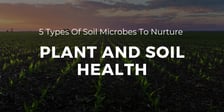By Kaitlyn Ersek on Jul 16, 2015 8:29:00 AM
When asked “What is soil?”, Dr. Bob, Director of Plant and Soil Sciences at Holganix, LLC replied, “Soil is the source for all food and fiber consumed on Earth. It is a medium composed of minerals, organic matter, water, air and living organisms. It provides infrastructure to support and nurture plants.” Let’s take a brief look at each of these key components.
1. Minerals
There are numerous different minerals, all charged with an important task to promote plant and soil health. Some of the key minerals include:
Carbon – The building block of all organic chemistry.
Calcium – In plants, calcium is a structural component of the cell wall. In plants, fungi and bacteria, calcium is a cofactor in regulating internal chemical processes. In soil, calcium shifts the pH to alkaline (vs acid).
Manganese – An essential element of chlorophyll (think Photosynthesis)
Nitrogen – All plant and animal proteins contain nitrogen. It is essential to life.
Potassium – An essential plant nutrient involved in the regulation of photosynthesis and water management in plants.
Phosphorous - an essential element in the biochemistry of photosynthesis, metabolism of sugars, energy management, cell division and the transfer of genetic material. In fact, phosphorous is essential to all life forms.
Sulfur – An important component of amino acids and proteins.
2. Organic Matter
3 to 5% of soil consists of organic matter. It is derived from dead and decaying plants and animals. It contributes to soil nitrogen, phosphorous and sulfur. The end result of organic matter is humus, which is created after microorganisms break down the organic matter.
3. Water
Water acts as a solvent and carrier for plant nutrients. Just like all animals, microorganisms require water for their metabolic processes.
4. Soil Air/Atmosphere
50% of soil volume consists of pore spaces filled with air and/or water. Gases found in soil air include: oxygen, nitrogen, carbon dioxide and water vapor. However, due to respiration of soil microorganisms, soil air has more carbon dioxide than the air we breathe (the atmosphere above the soil).
5. Soil Microorganisms
There are more microbes in 1/3 cup of soil, than there are people on earth! Soil microorganisms include: bacteria, fungi, algae, protozoa, arthropods, nematodes and worms. Often, tilled soil (soil used in agriculture and landscaping) is more bacterially dominant while non-tilled soil (soil found in a forest) is more fugally dominant.
Why Soil Health Matters @ Holganix
At Holganix we revolutionize the way the world grows by harnessing the power of soil microbes. In fact, our flagship product Holganix Bio 800+ contains over 800 species of beneficial soil microbes, that work to build soil and plant health naturally. Our products are used by farmers to increase crop yields and by landscapers and golf courses to reduce their need for fertilizer and pesticides. It’s official, SOIL MATTERS!
Learn more about Holganix's role in soil health by watching our webinar recording below featuring Holganix Director of Plant & Soil Science, Dr. Bob.
What’s The Dirt on Soil Science?
Digging into Soil Science 101: Beginners Guide to Understanding the Soil Food Web eBook
We know soils are important and we know why we should be grateful for healthy soils. But, how do soils work? And, what does healthy soil look like? Dig deeper into soil science by downloading our FREE eBook by Holganix Director of Soil and Plant Science, Dr. Robert Neidermyer.
Download our eBook to explore:
1. How the soil food web supports healthy crops
2. The power behind soil microbes and what they do to build resilient crops
3. Soil types and how to improve the health of your soil

%20(1).webp?width=721&height=380&name=Resize_download%20(40)%20(1).webp)

![Holganix Greater Green Goal [2024 Update]](https://www.holganix.com/hs-fs/hubfs/Blog%20headers%20%232%20%2875%29.jpg?width=224&height=112&name=Blog%20headers%20%232%20%2875%29.jpg)



![Holganix Greater Green Goal [2024 Update]](https://www.holganix.com/hs-fs/hubfs/Blog%20headers%20%232%20%2875%29.jpg?width=120&height=66&name=Blog%20headers%20%232%20%2875%29.jpg)








